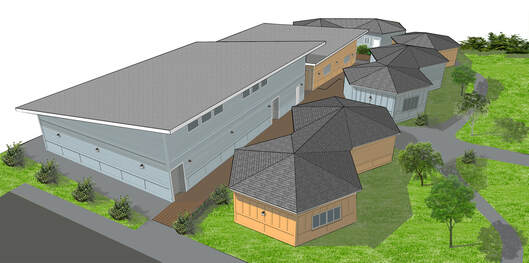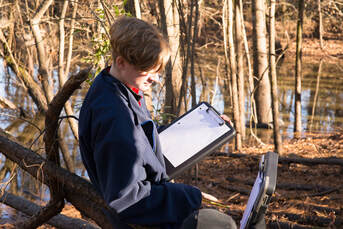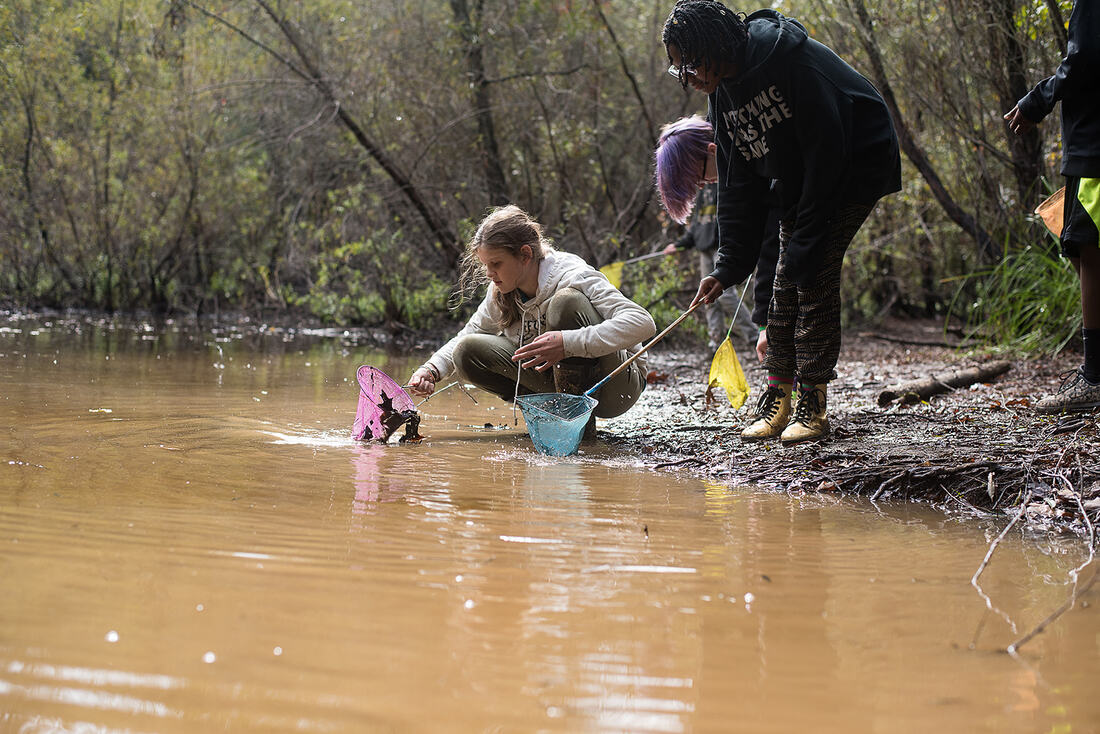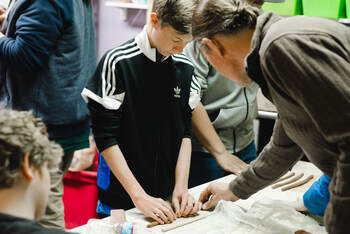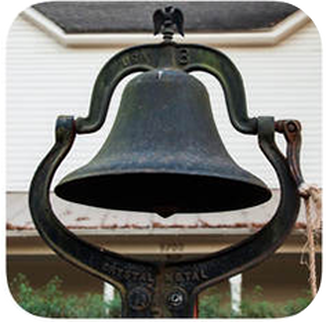The high School at Pioneer Springs
Be part of a culture driven by community. Personalize your learning experience to your interests and strengths. Develop marketable skills while exceeding the state requirements for graduation.
Our nature-rich setting invites students to learn both in and out of the classroom so let's take it outside...
The High School at Pioneer Springs invites students to pursue one of five Communities in Action designed to deliver a cohesive educational experience balanced with real-world applications and contributions.
Our nature-rich setting invites students to learn both in and out of the classroom so let's take it outside...
The High School at Pioneer Springs invites students to pursue one of five Communities in Action designed to deliver a cohesive educational experience balanced with real-world applications and contributions.
THE NEW HIGH SCHOOL COMPLEX
|
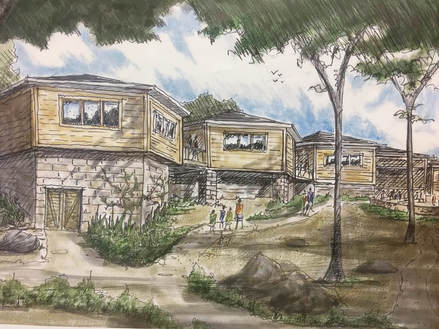
The High School at Pioneer Springs: An Agenda for Action
Basic School founder Dr. Ernest Boyer outlined the role of high schools in America and articulated an “agenda for action” in his 1984 text, High School. Central to Dr. Boyer’s ideas about successful high schools are the inclusion of:
It is upon Dr. Boyer’s tenets that Pioneer Springs developed its high school program comprised of five pathways through which students can pursue their personal and occupational interests while navigating academic requirements. All pathways include a heavy emphasis on core content in tandem with language and digital literacy development, as well as an integrated work component. PSCS high school students, teachers, and parents share a common goal that students will both fulfill the requirements for graduation as well as develop specialized skills that allow them to enter the workforce or pursue continued studies in a chosen field.
Pioneer Springs' Communities in Action
Pioneer Springs offers five Communities in Action which exceed state requirements and are aligned with the mission of PSCS and Dr. Boyer’s vision for the high school experience. In addition to earning a minimum of 28 credits toward graduation, scholars will complete the NC Graduation Project and enjoy authentic work experiences. All CIAs fulfill three specific goals: (1) they meet and exceed the North Carolina graduation requirements, (2) they result in both an earned diploma and unique skill set or certification for each graduate, and (3) they include consistent opportunities for authentic work experience.
Basic School founder Dr. Ernest Boyer outlined the role of high schools in America and articulated an “agenda for action” in his 1984 text, High School. Central to Dr. Boyer’s ideas about successful high schools are the inclusion of:
- clear goals shared by students, teachers and staff, and parents
- an emphasis on proficiency with both written and spoken English
- a focus on core classes (English, Math, Science, and Social Studies) as the majority of units required for graduation
- the development of digital literacy interwoven into the classroom experience and a consideration of social and ethical issues with technology
- time devoted to the opportunity to work and to consider the value of work within various cultures, different forms of work, and preparation for an occupation
It is upon Dr. Boyer’s tenets that Pioneer Springs developed its high school program comprised of five pathways through which students can pursue their personal and occupational interests while navigating academic requirements. All pathways include a heavy emphasis on core content in tandem with language and digital literacy development, as well as an integrated work component. PSCS high school students, teachers, and parents share a common goal that students will both fulfill the requirements for graduation as well as develop specialized skills that allow them to enter the workforce or pursue continued studies in a chosen field.
Pioneer Springs' Communities in Action
Pioneer Springs offers five Communities in Action which exceed state requirements and are aligned with the mission of PSCS and Dr. Boyer’s vision for the high school experience. In addition to earning a minimum of 28 credits toward graduation, scholars will complete the NC Graduation Project and enjoy authentic work experiences. All CIAs fulfill three specific goals: (1) they meet and exceed the North Carolina graduation requirements, (2) they result in both an earned diploma and unique skill set or certification for each graduate, and (3) they include consistent opportunities for authentic work experience.
The Humanities: Green Cultural Studies The Humanities: Green Cultural Studies describes the investigation of cultural objects and symbols, meanings, and actions with an eye and ear for their implications for environmental politics; that is, considering sign, symbol, and icon in literature, art, music, and other societal artifacts for understanding and improving the relations between individuals, communities, species, and places.
This is the pathway of language and literature, philosophy, history, politics, religion, and visual and performing arts. It is a good fit for someone who wants to be an anthropologist or archaeologist, an environmental educator or researcher, a teacher of professor, an artist, a writer or journalist, a museum curator, sociologist or psychologist, musician, ethicist or philosopher. |
Sustainable Business and IndustryThe Sustainable Business and Industry pathway focuses on production, consumption, entrepreneurship, and leadership. Utilizing both a scientific and career technical education approach, students will consider how to balance and plan for human and environmental needs in the context of sustainable agriculture production and resource utilization and management.
This pathway will prepare you for work in careers related to both creating and harvesting resources, designing and marketing products, sales, accounting, management of natural resources, and project management and leadership. This is the pathway of business ownership, accounting, marketing, product design, and free market economics. It is also the pathway for those interested in forestry, agriculture and animal sciences, becoming a park ranger, veterinarian or vet assistant. |
Designing the Future: Engineering, Technology, and ArchitectureThis pathway embodies elements of traditional engineering like planning and assessment, architecture, including design and development, as well as technology from coding to beta testing. It relies heavily on the incorporation and application of mathematics in various contexts and with an eye toward project management.
Follow this pathway if you are interested in pursuing a career as an architect or a landscape architect, a civil engineer, a cartographer, a surveyor, coder or a programmer, a hacker or an IT security technician, a CAD designer, or a construction expert. |
The Natural SciencesThe Natural Sciences refer to those sciences that use the scientific method to study nature and the universe. This pathway has many branches, including Physics, Astronomy, Atmospheric Sciences, Earth Science, Chemistry, Biology, Oceanography, Geography and Ecology, all of which provide a synthesis between theory and practical application.
Follow this pathway if you are interested in pursuing a medical career like a doctor or nurse or therapist, if you want to teach science or work in a forensics lab to solve crimes, or if you want to be a meteorologist, an astronomer, or an astronaut. This is the pathway of research scientists, hydrologists, chemists, and pharmacists. |
THE TEACHER APPRENTINCE
The Teacher Apprentice Community is inspired by the NC Teacher Cadet program and is designed for students who desire to teach in all the many contexts and capacities that includes–dance teachers, public school teachers, YMCA instructors, museum docents, and college professors to name a few.
This is a Community with three focal points: (1) expose students to the many applications of teaching, (2) train them in foundational teaching skills like lesson design, classroom management, and reflective practice, and (3) provide practical experience as a teaching assistants on the PSCS lower school campus toward developing confidence and capacity.

